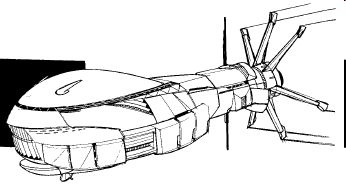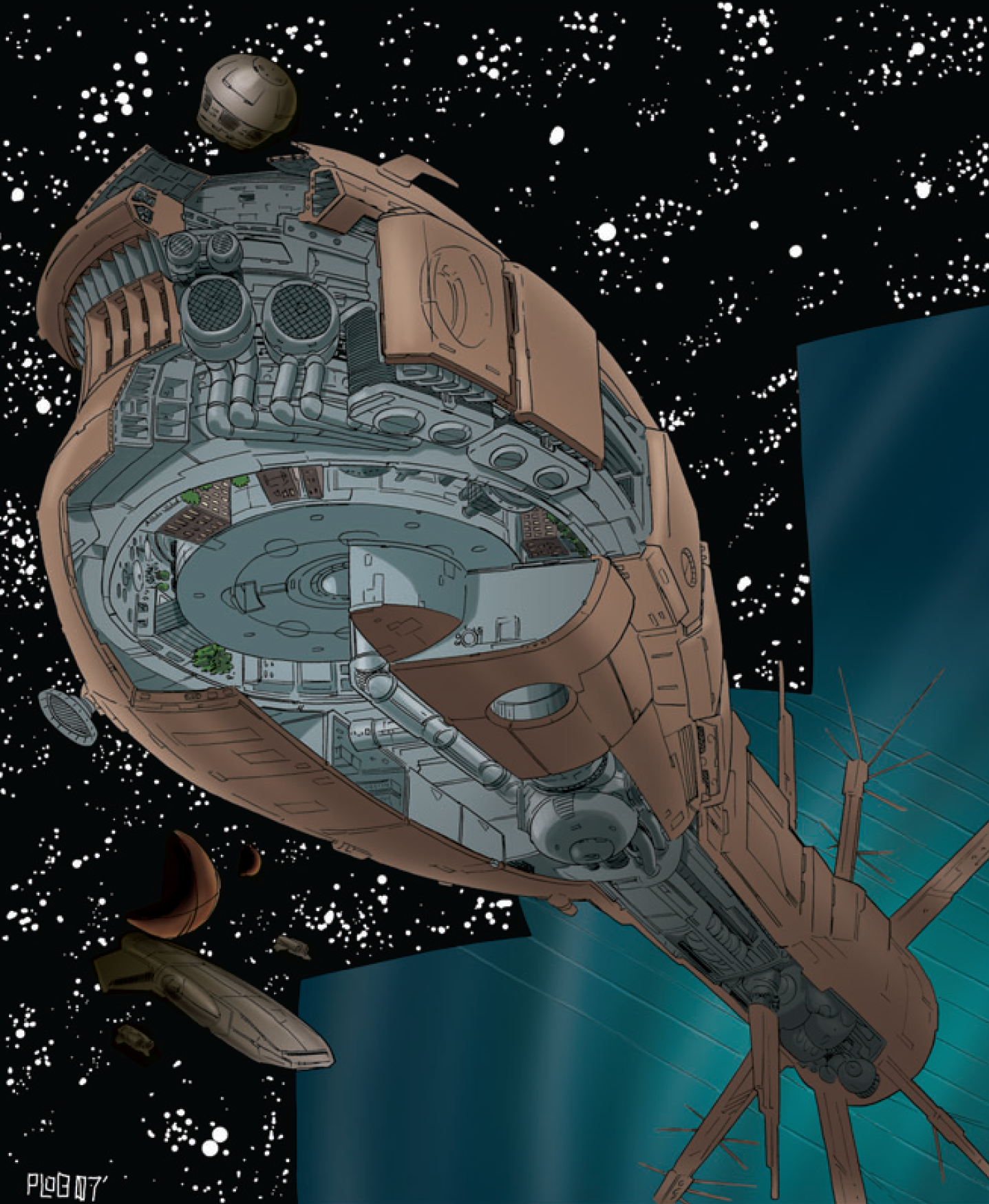
United Galaxies Council. | Power Stations. | 
United Galaxies Council. |
|---|
| Perhaps the best known stations of the UGC are power stations, located in many star systems. They are used to collect solar energy to convert it to electricity, which is then usually beamed to a planet or spacecraft, including interstellar ships; This energy does NOT work for spacefold systems, but most other space flight related systems can be powered this way. For chemical rocket thrust systems, the power stations can also be fitted with hydrogen collection ports and filters (to separate the hydrogen, especially the highly valuable H3, from other stellar dust).Power stations use solar sails to store energy in massive batteries. The energy storage batteries can in turn deliver the energy to star/spaceships either by microwave transmission or by hard lines.The advantage of recharge stations to spacecraft operators is sometimes lost on novice observers, since recharge stations do not usually allow starships to recharge faster than the normal; Most systems visited by starships cannot generate a full charge at a standard jump point, with some dim stars requiring more than three additional days. To merchants, who detest wasting even an extra six-hour shift in port and dread the accumulation of lost recharge hours over a fiscal year, the guaranteed of a recharge is worth the expense. They are also convenient to merchants with balky sail deployment mechanism, a common problem for the mile-wide, tissue-thin solar sails. And typically they're safer; To date there has only been one accident attributed to power stations (that being a the replacement of a Type IZ3 fuse with a 1/2" steel pipe, causing a fire on board the power station; the merchant vsl was undamaged).Recharge stations almost always have additional duties. They act as refueling platforms, cargo transshipment points, entrepôts and customs checkpoints. Apart from that, power stations also function as cargo and fueling stations and many of them form the core of orbital defense systems (usually as sensors platforms). Some also support additional facilities, such as repair docks.Power stations are rarely subjected to a direct assault because they are far too valuable to be damaged. Recharge stations act as system defense surveillance stations due to the number of ships that pass through zenith and nadir points, but this fact is so well known and the presence of a recharge station is such public knowledge that raiders will typically either use the other standard point (many systems do not have two recharge stations) or use a covert operation to disable the station's surveillance system. Destruction of a recharge station, despite the risk the station presents to raiders, is rare because recharge stations are also useful to the invaders. They have been, however, targeted by black-ops attacks in order to take out the sensor network they control, prior to a planetary assault. These are very often in the form of takeovers, designed to ensure that the invaders/raiders entry into the system is not alerted to the higher command; Also, the attackers need recharge their own power.DescriptionPower stations feature huge solar sails and can store vast amounts of energy, which they can transfer to waiting starships by microwaves, significantly shortening the recharge time due to concentrated energy flow. The ships themselves are typically decommissioned hulls of medium size, stripped out of their equipment for their previous duties and replaced with batteries and/or capacitors to store energy for transfer. Because they don't require very large crews, most of the berthing is converted to rather comfortable by starship standards, though the messing arrangements are not terribly exciting (since the galleys can't be readily converted, and in any case it's the same thing for months on end). They rarely retain their FTL or spacefold drives, since they're not expected to go anywhere.ConstructionMost power stations are built from decommissioned medium-sized starships, with the single most popular type being the RENORBY-Class AS. Small-sized starships (such as the GARFISH- and HORIZONT-Class Assault Shuttles, both now largely out of militry service) can not support sails large enough to be cost effective, and large starships (such as the Sojourner-Class cargo ships) require too much supplies (fuel, food, etc) to be cost-effective. Most standard spacestations "can" be power stations, but it's not typically cost-effective for them.ArmamentTypically a power station is lightly armed to protect them from space junk and the incident stray attack (usually missile). They simply are too valuable to each faction, even those opposed to the UGC, to attack openly; Only the Magog and Palpatinians disrespect the neutrality of these facilities- The Magog typically ignore them (they sometimes take a few harassment shots at them), and the Palpatinians attack them only to deter pursuit (damaging their thrusters, causing them to drift in space, forcing other ships to race to their rescue). Even the latter is relatively rare, since the Palpatinians know it just pisses everyone off, resulting in retaliation. The former is not rare (in fact it's par for the course), but the damage inflicted is miniscule (even macroscopic), and the Magog threat is diminishing at any rate (in fact, it's thought they may be extinct). | Power Stations. |
|---|
 |
| Production Information: |
|---|
| Manufacturer: | Many. |
|---|
| Type: | Recharge Stations. |
|---|
| Technology: | Basic. |
|---|
| Cost: | Generally low. |
|---|
| Introduced: | Late 21 century. |
|---|
| Technical Specifications: |
|---|
| Mass: | Around 1 million tons. |
|---|
| Length: | Based on original hull. |
|---|
| Width: | Based on original hull. |
|---|
| Thrust: | None. |
|---|
| Fuel: | About 10 times original hull. |
|---|
| Batteries: | Up to 20 months plus whatever they need to sell. |
|---|
| Armament: | - Shields (21,000 MDC);
- Point Defense Weapons Systems (5);
- Short Range Weapons (10);
- Space Fighters (2-4 Squadrons);
- Armored Hull; Super Heavy.
|
|---|
| Armor: | Heavy. |
|---|
| Docking Collars: | Many. |
|---|
| Crew: | Small. |
|---|
| Passengers: | None. |
|---|
 |
| Cut-Away. |
|---|
| General Information |
|---|
| Name: Power Stations.Location: Many systems around the UGC.Size and Orientation: Small outpost (150). | Function: Industrial (+10 Power Systems, +10 Supplies) and Militry (+20 defense, +10 Internal Security, +10 Supplies)
|
| Features: |
|---|
| A: Power System: | B: Defenses: | C: Sensors: | D: Communications: |
|---|
- Nuclear, Solar, and Battery Power (0)
- Fusion (10)
| - Shields (3₧ every 3,000 MDC)
- Point Defense Weapons (5)
- Armored Hull: 60₧/75%
| - Satellites: Short Range (2₧/6 Sats) and Medium Range (4₧/6 Sats)
- Enhanced sensors (20)
| - Stellar Communications (40) with Long Range (18₧/9 Sats) and Interstellar Satellites (40₧/02 sats).
|
| E: Station Maintenance: | F: Supplies: | G: Internal Security Personnel: | H: Medical Facilities: |
|---|
| - Semi-Self-Sufficient (10)
| | |
| I: Environmental Systems: | J: Independent Business: | K: Transients: | Adjustment: |
|---|
| | | - Additional ₧ by UGC allied patronage.
|
| MDC By Location: |
Laser Turrets (30)
Missile Turrets (30)
Shuttle Bay Door (10 around hull)
Airlocks/Access Hatches (many)
Outer Hull (per 12 meter area) | 150 each
100 each
3,000
100 each
100 | Interior bulkhead (per 66 foot area)
* Forward 1/3
** Main Thrusters (2, Rear)
Secondary Thrusters (1, rear)
| 20
50,000
7,500 each
4000
|
Notes:* Depleting the MDC of the forward section means that the forward Third of the ship has been destroyed. This includes the main cannon and the command center. Nothing on the ship, including life support, engines, and weapons will work, leaving the ship a floating wreck.** Depleting the MDC of the main engines will force the ship to rely on its secondary engines. Depleting the MDC of the main engines AND secondary engines will leave the ship adrift in space. If in an atmosphere, the ship will crash (destruction of the main engines will render the antigravity system useless due to loss of power).
Speed and Statistical Data: |
Speed (Sublight): 0.001 speed of light.
Speed (Conventional Drives): Can maintain 0.23g for 5 hours 6 minutes; Capable of 1.1g for 38 minutes; and the emergency thrusters can propel a T'sentraedi vessel at 2.1g for 10.8 minutes.
Space Fold: Range Unlimited.
Planet bound: Can land if necessary but not designed to maneuver in an atmosphere. Maximum speed limited to Mach 1.
Maximum Range: Unlimited (Protoculture generator has an estimated 30 year life span).
Length: 3,997 feet 4.5 inches.
Clearance: 1,809 feet 6 inches. | Beam: 1,250 feet 1.5 inches.
Displacement: 25,300,000 tons.
Cargo: Varies, but most expand their capacity to 1/4 tons with the ability to support shuttles (docking collars and bays), making them a vital center for any incoming cargo ships.Fold System: Shik-Telnekulla fold system cluster (if any).
Sublight Drive: Geteulmaqulla-Zollia gravity control system.
Gravity Control System: Geteulmaqulla-Zollia gravity control system.
Auxiliary Engine: Workl-Quatafilla macro nozzle cluster.
Cost And Availability About 10millioncredit; Fairly rare, though. Though it has become more popular with the UGC due to its cost, it was never really popular with the malcontent crowd outside the T'sentraedi. |
| Weapons Systems: |
|---|
1. Missile Turrets: Scattered across the ship. The turrets are normally concealed within the ship's hull, but rise up when needed to attack the enemy. Each turret can rotate 360 degrees with a 180 degrees arc of fire.
Missile Types: Any type of Long Range Missile can be used. Reflex missiles are commonly used to avoid hitting friendly aircraft.
MD and Range: Varies.
Rate Of Fire: Each turret can fire one missile once per melee.
Payload: Effectively unlimited (hundreds of missiles). | 2. Mecha: The main defense is utility to all, but Mecha remain on board.150 Veritechs.200 Guardians.500 Destoids.300 Space Fighters.9 Officer's Pods (Old Type).04 Shuttles.
Exact types of each varies by ownership. |
| Features: |
- ESM: Radar Detector. Passively detects other radars being operated.
- Radar: Combat grade radar. Range 100 miles, can track up to 50 individual targets. 95% reliability (24% against unfriendly stealthed vehicles).
- Blue Force Tracker: Identifies friend from foe. Overlays the information on both the radar and HUD, ensuring that friendly forces are not accidentally targeted.
- GPS: Standard tracking device. Ties into the Blue Force Tracker.
- Anti-Jamming System: Reduces Electronics Countermeasure by 25% (decrease skill level appropriately).
- HUD: Displays maps, radar, targeting information, and any OTHER information the wearer wants directly in front of the user. One is located at each weapons control station, and another makes up the majority of the bridge.
- FLIR/SLIR: Forward and Side Looking Infrared. Allows pilot to get visuals on targets at night.
- 1 MC: Internal loudspeaker.
| - Virtual Map: Displays a continuously-updating map of local terrain for the bridge. Takes data from and gives data to other friendly units in the area. Effective navigation of 85% as updates come. Good to 500 miles. Specific range can be adjusted in 10,000 mile increments.
- Video Camera: Records from the HUD. 5,000 hours of recording available.
- Full range optic sensory suite: Infrared, ultra violet, Magnification, night sight, color filters, thermal imager. Range is about 200 miles for MOST sensors.
- Survival Pack: A pack of simpler emergency survival supplies: Pup tent, sleeping bag, black light, GPS, First aid kit (bandages, gauze, bandage tape, pads, antiseptic/analgesic), plasma torch (for small repairs and starting fires), repair kit (with MDC Repair Spray), sewing kit (a small spool of thread and 5 needles), 7 star flares (250 feet apogee), 2 white parachute flares (1,500 feet apogee), 100 feet of black or brown parachute cord (150 lbs tensile strength), 2-5 days rations, 2 gallons water, water purification kit- good for about 10 gallons.
|
Combat Profile for an average Power Station:- 8 total attacks per melee.
- +4 Initiative.
- +6 Strike.
- +5 Dodge.
|
|



